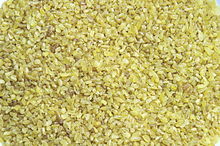Bulgur (Turkish: bulgur; Armenian: բլղուր, romanized: blghur; Persian: بلغور, romanized: bolġur/balġur, lit. 'groats'),[1] or burghul (Arabic: برغل, romanized: burġul),[2] is a cracked wheat foodstuff found in West Asian cuisine.

Characteristics
| Nutritional value per 100 g (3.5 oz) | |
|---|---|
| Energy | 83 kcal (350 kJ) |
18.58 g | |
| Sugars | 0.10 g |
| Dietary fiber | 4.5 g |
0.24 g | |
3.08 g | |
| Vitamins | Quantity %DV† |
| Vitamin A equiv. | 0% 0.0 μg |
| Vitamin A | 1 IU |
| Thiamine (B1) | 5% 0.057 mg |
| Riboflavin (B2) | 2% 0.028 mg |
| Niacin (B3) | 6% 1.000 mg |
| Vitamin B6 | 5% 0.083 mg |
| Folate (B9) | 5% 18 μg |
| Vitamin C | 0% 0.0 mg |
| Vitamin D | 0% 0 μg |
| Vitamin E | 0% 0.01 mg |
| Vitamin K | 0% 0.5 μg |
| Minerals | Quantity %DV† |
| Calcium | 1% 10 mg |
| Iron | 5% 0.96 mg |
| Magnesium | 8% 32 mg |
| Phosphorus | 3% 40 mg |
| Potassium | 2% 68 mg |
| Sodium | 0% 5 mg |
| Zinc | 5% 0.57 mg |
| Other constituents | Quantity |
| Water | 78 g |
| †Percentages estimated using US recommendations for adults,[3] except for potassium, which is estimated based on expert recommendation from the National Academies.[4] | |
Bulgur is sometimes confused with cracked wheat, which is crushed wheat grain that, unlike bulgur, has not been parboiled.[5] Bulgur is a common ingredient in cuisines of many countries of the West Asian cuisine and Mediterranean Basin.[6][self-published source?][7][8] It has a light, nutty flavor.[9]
Bulgur is recognized as a whole grain by the United States Department of Agriculture.[10]
Composition and nutrition
Cooked bulgur is 78% water, 19% carbohydrates, 3% protein, and contains negligible fat (table). A 100 gram (3.5 oz) reference serving supplies 83 kilocalories. A study of uncooked samples from different sources found, with some variation between samples, about 9% protein, 11% moisture, 1% ash, 70% starch of which 2-2.8% beneficial resistant starch, 7% fibre, mostly beneficial insoluble fibre.[11]
Culinary uses

Bulgur does not require cooking, although it can be included in cooked dishes; soaking in water is all that is needed.[12]
Coarse bulgur is used to make pottages,[13] while the medium and fine grains are used for breakfast cereals,[14] salads such as kısır, pilavs, breads,[15] and in dessert puddings such as kheer.[16][17] Bulgur porridge is similar to frumenty, a cracked wheat porridge that was a staple of medieval cuisine.[18][19]
In breads, it adds a whole-grain component. It is a main ingredient in kibbeh and, soaked but not cooked, in tabbouleh salad. It is often used where rice or couscous could be used. In Indian and Pakistani cuisine, bulgur is often used as a cereal to make a porridge with milk and sugar, or a savory porridge with vegetables and spices. It can be used to accompany other dishes in the same way as pasta or rice; it may be mistaken for rice because it has a similar appearance, although the texture is different.
Armenians prepare bulgur as a pilaf in chicken stock, with or without sautéed noodles, or cooked with tomatoes, onions, herbs and red pepper. The fine grind is used for making eech, a bulgur salad similar to tabbouleh, prepared with tomato paste, fresh tomatoes, cucumbers, parsley, olive oil, and other salad ingredients to personal taste. Pomegranate molasses, which is sour and sweet, is commonly used instead of lemon juice to add tartness. A variety of mezes and main dishes are prepared.
In Greece, it is known as πλιγούρι (pligouri) and in Cyprus as πουρκούρι (pourkouri), where it is used to make κούπες (koupes, known as içli köfte in Turkish), a variety of kibbeh. It is deep-fried, with a crust made of fine bulgur, flour, oil, salt and egg, filled with ground meat (beef and/or pork), onions, parsley and spices.
The Saudi Arabian version of bulgur, popular in Nejd and Al-Hasa, is known as jarish (Arabic: جَريش).[20]
See also
References
External links

